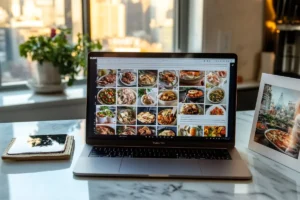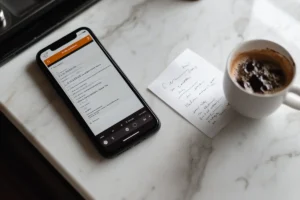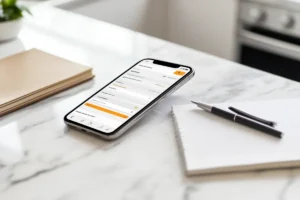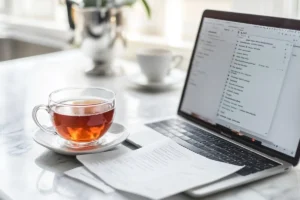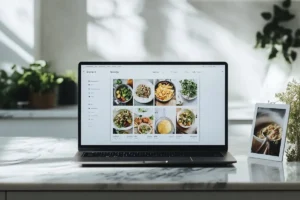What is the Best Way to Digitize Recipes?
What is the best way to digitize recipes? It’s a question I hear more and more lately—and for good reason.
Recipes aren’t just lists of ingredients. They’re pieces of our history. In my kitchen, there’s a recipe card stained with tomato sauce that belonged to my grandmother. She wrote it out by hand in her Brooklyn apartment, probably while simmering a pot of her famous Sunday sauce.
That little card is priceless. But it’s also delicate and fading. That’s exactly why I started thinking about digitizing my recipes—to protect those memories and make them easy to share with my family.
In this article, I’ll walk you through simple, practical ways to digitize your recipes—without losing their flavor or charm. Whether you’re saving a family favorite or organizing your weeknight dinners, I’ll show you how to do it in a way that’s quick, satisfying, and even a little fun.
Why Digitize Recipes?
You might be wondering—why go through the trouble? What is the best way to digitize recipes if you already have them written down or tucked away in a cookbook?
Well, let me tell you—digitizing recipes isn’t just about saving space. It’s about preserving memories and making life easier in the kitchen.
Here’s why it matters:
-
Protect Your Family Traditions:
Old recipe cards fade, tear, and sometimes get lost. Digitizing keeps them safe for the next generation. -
Stay Organized:
No more digging through drawers or flipping through pages. You’ll find what you need with just a few clicks. -
Share with Loved Ones:
Ever get a text asking for your mac and cheese recipe? When it’s digitized, you can send it in seconds. -
Plan Meals Faster:
Sorting recipes by type, ingredient, or occasion helps you plan dinner without stress.
A personal note from my kitchen:
When I first scanned my grandmother’s meatball recipe, I felt a little odd. It wasn’t on her old notecard anymore. But you know what? Now I can pull it up on my phone while shopping—or send it to my niece in college. That’s the magic of digitizing.
It’s not about replacing the heart of a recipe. It’s about keeping that heart alive in a new way.
What is the Best Way to Digitize Recipes? 5 Simple, Satisfying Methods
Let’s get straight to it—what is the best way to digitize recipes? I’ve tried a lot over the years, and I’ve found a few methods that are not only easy but actually enjoyable.
You don’t need fancy tools or tech skills. You just need a system that works for you. Here’s what I recommend:
1. Scan and Save: Classic but Effective
This is how I started. I took my old recipe cards, ran them through a scanner, and saved them to my computer.
No scanner? No problem. Use your phone. Apps like:
- Adobe Scan
- Google Lens
- CamScanner
These let you snap a photo and turn it into a PDF right away.
Tips:
- Save each recipe with a clear name:
Grandma_Rice_Pudding_1952.pdf - Create folders by category: Appetizers, Mains, Desserts
- Backup your files on a cloud drive like Google Drive or Dropbox
Sylvia’s note: I scanned my grandmother’s recipes one Sunday afternoon. The best part? I could finally zoom in on her faded handwriting and see every little loop and swirl again.
3. Use Recipe Organization Apps
If you want something all-in-one, try an app made just for recipes. These are my favorites:
| App Name | Best For | My Favorite Feature |
|---|---|---|
| Paprika | Full recipe management | Auto shopping list builder |
| Whisk | Social sharing and planning | Easy ingredient import |
| Cookpad | Community recipe sharing | Real home-cook feedback |
These apps let you:
- Clip recipes from websites
- Add your own notes
- Sort by ingredient, meal type, or prep time
Sylvia’s experience: I use Paprika when I plan big dinners. It keeps me sane when my kids are yelling and the garlic is burning!
4. Voice-to-Text & Smart Tools
Here’s a modern trick I love: speak your recipes out loud while you cook.
Use:
- Voice Memo apps
- Google Docs Voice Typing
- Otter.ai transcription tool
Later, you can clean up the text and save it.
Sylvia’s tip: Sometimes I record my thoughts while cooking—”Add a little more cinnamon here, it brings out the vanilla.” It’s a real-time way to capture your flavor tweaks.
5. Build Your Own Recipe Archive
If you love organizing (like I secretly do), take it a step further. Make a:
- Digital Cookbook (PDF or eBook)
- Spreadsheet Index
- Private blog or family recipe site
Example Spreadsheet Columns:
| Recipe Name | Cuisine | Prep Time | Family Rating | Notes |
|---|---|---|---|---|
| Zucchini Fritters | Greek | 30 mins | 5 stars | Add dill for more punch |
My dream project: I’m building a digital family cookbook with audio stories, scanned cards, and little notes from my kids. It’s a mix of memory and flavor—and it feels so special.
What is the Best Way to Digitize Recipes While Keeping Them Authentic?
Now here’s something close to my heart—how do we keep recipes authentic when we digitize them? That’s just as important as saving them.
Because let’s be honest, a digital file is neat and tidy. But recipes? Recipes are messy. They have smudges, margin notes, and splashes of sauce. They carry stories.
So what is the best way to digitize recipes without losing that flavor—the soul behind the spoon? Here’s what I’ve learned in my own kitchen.
1. Keep the Handwritten Charm
When I scan my grandmother’s recipes, I don’t crop out the ink stains or the crossed-out lines. That’s history.
If you’re scanning or taking photos, include:
- The original paper
- Any handwritten notes or doodles
- Smudge marks (yes, even the cocoa powder ones)
2. Add Personal Notes Digitally
Typing your recipes? No problem. Just add a section called “Memory Notes” or “Kitchen Story.”
For example:
“Grandma always said to toast the spices before adding them. She claimed it woke them up—just like she did with us on school mornings.”
Little notes like that keep the recipe alive and personal.
3. Include Audio or Video
Sometimes, voice tells a story better than text. I’ve started recording short audio clips with each recipe—just me talking about where it came from or how I learned it.
If you’re making a digital cookbook or private blog, add:
- Audio memories
- Quick video clips (even just from your phone)
- Family voices reading old recipes
4. Save Versions with Variations
In my family, we make the same dish a dozen different ways. My mom adds more garlic, I cut back on salt, my daughter adds chili flakes.
Don’t overwrite the old version—just add a new one. Label it like this:
- “Original Rice Pudding – Grandma’s Version”
- “Rice Pudding – Sylvia’s Creamier Twist”
This honors every version without erasing what came before.
5. Organize Recipes Around Memories, Not Just Meals
Try creating folders or categories that reflect emotions or traditions, not just food types.
Some of mine include:
- “Rainy Day Recipes”
- “Sunday Suppers”
- “Brooklyn Favorites”
It’s a small shift, but it keeps the soul of your cooking story front and center.
Sylvia’s Final Thought on Authenticity
Digitizing recipes isn’t about turning them into cold files. It’s about preserving warmth in a way that lasts longer.
So ask yourself: What is the best way to digitize recipes so my children and grandchildren still feel that warmth when they read them?
That’s your answer.
Sylvia’s Cooking Philosophy: Simple, Flavorful, Real
If you’ve spent any time on DawnRecipes.com, you already know my kitchen mantra: Keep it simple, keep it flavorful, keep it real.
That same philosophy shapes how I cook—and how I digitize recipes.
Because what is the best way to digitize recipes if it doesn’t also reflect the spirit behind them?
1. Simplicity Always Wins
I don’t believe in overcomplicating food—or organizing it. When I digitize a recipe, I want it to be:
- Easy to find
- Easy to follow
- Easy to share
That’s why I avoid cluttered systems or apps with too many bells and whistles. If I can’t open a recipe while stirring a pot with one hand and helping my kid with homework, it’s too complicated.
2. Flavor Comes First
A recipe isn’t just about instructions. It’s about how it tastes—how it makes people feel around the table.
So when I type up a recipe or record a voice note, I include things like:
- “Add a squeeze of lemon if it tastes flat.”
- “Let the stew sit 10 minutes before serving—it gets better.”
These flavor tips might not look technical, but they’re the real heart of a good dish.
3. Real Food, Real Stories
What is the best way to digitize recipes if we leave out the stories behind them?
Don’t just save the ingredients—save the moments:
- The time your child spilled cinnamon everywhere.
- The year your apple pie won the church bake-off.
- The way your mother hummed while folding dumplings.
I believe food is storytelling. So digitizing recipes isn’t just a chore—it’s a way to keep telling those stories, even years from now.
My Final Note on Cooking Philosophy
Whether you’re organizing your weeknight dinners or creating a full family cookbook, make sure it still feels like you. Let your food—and your recipe archive—tell your story with honesty and heart.
That’s the real recipe worth saving.
Cultural Touches & Recipe Variations
Recipes are more than instructions. They carry the flavor of where we come from. That’s why, when I ask myself what is the best way to digitize recipes, I also ask: How do I keep their roots intact?
Whether your recipes come from Brooklyn, Bombay, or your backyard, they reflect culture, history, and adaptation over time.
1. Recipes Change Across Generations
Take my grandmother’s stuffed peppers. She made them with ground beef, rice, and a pinch of cinnamon—a nod to her Mediterranean roots.
When I make them today, I add quinoa and roasted garlic. My daughter? She swaps in lentils and hot sauce.
The heart of the dish stays the same. But the hands that make it change.
When digitizing, it’s worth saving those variations. In fact, I recommend creating a section in your recipe archive for:
- “Original Version”
- “Modern Adaptation”
- “Family Favorite Variation”
This way, you celebrate every cook who’s touched that dish.
2. Honor Cultural Flavors in the Notes
Sometimes, a small detail holds cultural meaning—like why we use rosewater in a pastry or why we always serve challah on Fridays.
Add a few words in your recipe notes:
- “This spice blend comes from my aunt’s Tunisian pantry.”
- “In my family, we serve this at Eid—always with mint tea.”
Those notes tell readers more than just how to cook—they tell them why it matters.
3. Add Tags That Reflect Culture
If you’re using folders, spreadsheets, or apps, try organizing by cultural background too. It adds depth and makes searching easier.
For example:
- Italian Comfort Dishes
- Mexican Street Food
- Korean Home Cooking
- Jewish Holiday Recipes
It’s a simple step that brings a personal touch to your digital archive.
Sylvia’s Thought on Tradition and Innovation
What is the best way to digitize recipes that come from tradition? By honoring where they began while embracing where they’re going.
Recipes evolve. That’s part of their beauty. Digitizing them lets us celebrate the past and leave space for the future.
FAQ – What is the Best Way to Digitize Recipes? Related Questions Answered
You’ve got questions—I’ve got answers. I pulled together the most common things people ask me when they start digitizing their recipes. Let’s tackle them one by one.
1. Can I digitize recipes without using apps or fancy software?
Absolutely. You can start simple:
- Type them into a Word or Google Doc
- Scan them using your phone camera
- Save them in organized folders on your computer
That’s it. No apps required—just a little consistency.
2. What if I’m not tech-savvy?
You don’t have to be! Choose a method that feels comfortable:
- Stick with typed documents
- Use a recipe binder with printed PDFs
- Ask a family member to help you get started (it makes a great bonding project)
Remember: the best way to digitize recipes is the one that feels easy, not overwhelming.
3. Is it safe to store my recipes online?
Yes—if you back them up properly. I suggest:
- Saving to a trusted cloud service like Google Drive or Dropbox
- Keeping a backup on an external drive or USB
- Password-protecting private recipe folders, especially family-only collections
4. How do I save handwritten recipes?
Scan them or take a clear photo with your phone. Then:
- Save as PDF or image files
- Add personal notes digitally
- Optionally transcribe the text below the photo for easier reading/searching
Sylvia’s tip: Don’t toss the original card. Frame it or keep it in a safe place—it’s still a treasure.
5. Can I include photos or videos in my digital recipe archive?
Yes, and you should! Photos bring your recipe archive to life:
- Include a picture of the final dish
- Add short video clips of key steps
- Even voice recordings telling the story behind the dish
It adds warmth and helps younger generations learn more easily.
6. What if I have recipes in multiple places—binders, websites, sticky notes?
Start small. Pick one recipe at a time to digitize. Group them in one folder. Over time, your collection will grow.
You don’t need to do it all in one weekend. Think of it like meal prep—just do a little at a time, and you’ll build something wonderful.

